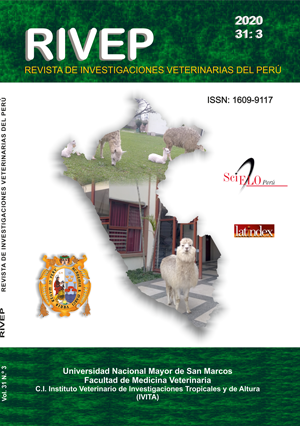Concordance between presumptive and tomographic diagnosis in dogs with encephalic and spinal diseases
DOI:
https://doi.org/10.15381/rivep.v31i3.18167Keywords:
herniated disc, computerized tomography, presumptive diagnosis, dogsAbstract
The aim of this study was to determine the concordance between the clinical and tomographic diagnosis in dogs with brain and spine illnesses. An analytical retrospective observational study was carried out, evaluating 196 clinical histories and tomographic reports of veterinary clinics in Metropolitan Lima during the period 2009-2015. This included 76 brain and 120 spinal tomography scans. Of the total of patients, 113 were males (58%) and 83 females (42%) and 120 cases (61.2%) corresponded to purebreds. The main diseases diagnosed clinically and by computed tomography (CT) were thoracolumbar hernia, canine epilepsy, hydrocephalus, and cervical hernia. The clinical diagnosis was related to the presence of a pathology diagnosed by CT using the kappa index and the concordance was classified as poor (k = 0.38). It is concluded that the presumptive clinical diagnosis and CT have very low concordance when diagnosing a disease or injury in the brain or spinal cord.
Downloads
Downloads
Published
Issue
Section
License
Copyright (c) 2020 Eben Salinas C, Néstor Falcón P.

This work is licensed under a Creative Commons Attribution-NonCommercial-ShareAlike 4.0 International License.
AUTHORS RETAIN THEIR RIGHTS:
a. Authors retain their trade mark rights and patent, and also on any process or procedure described in the article.
b. Authors retain their right to share, copy, distribute, perform and publicly communicate their article (eg, to place their article in an institutional repository or publish it in a book), with an acknowledgment of its initial publication in the Revista de Investigaciones Veterinarias del Perú (RIVEP).
c. Authors retain theirs right to make a subsequent publication of their work, to use the article or any part thereof (eg a compilation of his papers, lecture notes, thesis, or a book), always indicating the source of publication (the originator of the work, journal, volume, number and date).










